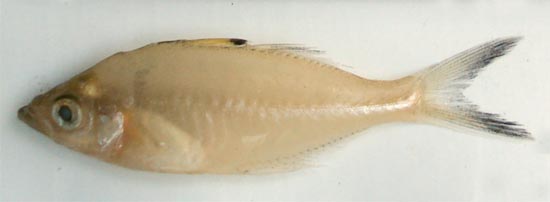
Synonyms:
Chanda nama: Hamilton, 1822; Rahman, 1974; Bhuiyan, 1964.
Ambasssis nama: Day, 1878; Day, 1889; Ahmad, N. 1943; Shaw and Shebbeare, 1937.
Common name: Elongate glass-perchlet (English name).
Bangla name: Chanda, Nama chanda.
Taxonomic position:
Phylum: Chordata
Class: Osteichthyes
Order: Perciformes
Family: Centropomidae
Genus: Chanda
Species: C. nama
Morphological description:
Body is strongly compressed and laterally almost flat. Dorsal and ventral profile of this fish is almost equally convex. Lateral line is partly distinct, partly absent. Second dorsal spine is longest. Spines of first dorsal and rays of second dorsal gradually decrease in height. Scales are minute and rounded. Caudal fin forked. Body is transparent yellowish white with numerous tiny black dots. First dorsal and tip of second dorsal is deep black. Caudal fin is black and orange. A small black spot is found at the origin of the base of anal fin. Lower jaw is longer than upper jaw. Morphological description of Chanda nama is similar to Rahman (2005) and Bhuiyan (1964).
Fin formula:
D1. VII-VIII, D2. I/15-18, P1. 11-13, P2. I/5, A. III/15-17.
D1. 7, D2. 14-18, P1. 12-13, P2. 6, A. 3/14-17 (Bhuiyan, 1964).
D1. VI, D2. I/13-17, P1. 12-13, P2. 6, A. III/14-17 (Shafi and Quddus, 1982).
D1. VIII, D2. I/16-17, P1. 12-13, P2. I/5, A. III/16-17 (Rahman, 2005).
D. VII+I 15-17, P1. ii 11-12, P2. I 5, A. III 15-17 (Talwar and Jhingran, 2001).
Habit and habitat:
This small fish is seen in the clear freshwater of rivers, streams, canals and beels. Specially in the rainy season these are abundantly found from the marginal area of the jute and paddy fields (Bhuiyan, 1964). According to Job (1941b) Ambassis nama feeds at all layers of water, subsisting mainly on the minute entomostracans. It is hardy and can stand foul water. Iqbal, et. al. (1995-96) also described about feeding habit of Chanda nama.
Breeding time:
Breeding time of this species is July-November. It breeds in confined water (Bhuiyan, 1964).
Economic importance:
This fish is well known as a small Indigenous Species (SIS) of fish of Bangladesh. Most of them are taken for drying in Northern region of Bangladesh. These drying chanda fish consume in local market. People use it as the part of their delicious food item. It is very much famous food in rural Bangladesh. Good source of nutrition but low price in the market (Bhuiyan, 1964 and Talwar and Jhingran, 2001).
Ecological role:
The presence of these fishes checks mosquito breeding only to a small extent while it effectively reduces the density of cyclops. So, this species could effectively be used in the control of guinea worms and also for malarial control (Bhuiyan, 1964).
Marketing status:
Market price of fresh fish is recorded 30-50 Tk/kg.
References:
Ahmad, N. 1943. “Fauna of Lahore. 5 Fishes of Lahore”. Bull. Dep. Zool Punjub Univ. Lahore. p. 336.
Bhuiyan, A.L. 1964. Fishes of Dacca. Asiatic Soc. Pakistan, Publ. No. 13, Dacca. pp. 99-100.
Day, F. 1878. Fishes of India. William Dowson and sons., London. p. 50.
Day, F. 1889. Fishes. Fauna. Brit. India. William Dowson and sons., London. II: p. 484.
Hamilton, F. 1822. Fishes of the Ganges. Archibald constable and company, Edinburgh. p. 109.
Iqbal, S.M., Mortuza, M.G., Parween, S. and Hossain, M.A. 1995-1996. Length-weight relationship and condition factor of chanda nama (Hamilton) and chanda ranga (Hamilton). Rajshahi University studies (Part-B). 23-24: pp. 238-242.
Job, T.J. 1941b. “Food and feeding habit of the glass fishes, Ambassis cu. and val.” Indian. J. Med. Res. Calcutta. 29(4): pp. 851-862.
Rahman, A.K.A. 1974. Bulletin Freshwater Fisheries Resources. Bull. Fresh. Fish. Res. Sta. Chandpur. p. 18.
Rahman, A.K.A. 2005. Freshwater Fishes of Bangladesh. The Zoological Society of Bangladesh, Dhaka. p. 339-340.
Shaw, G.E. and Shebbeare, E.O. 1937. Fishes of Northern Bengal. J. Royal Asiat. Soc. Bengal Science. p. 110.
Talwar, P.K. and Jhingran, A.G. 2001. Inland Fishes of India and Adjacent countries. Oxford and IBH Publishing Co. Pvt. Ltd. New Delhi. 2: p. 800.
Shafi, M. and Quddus, M.M.A. 1982. Bangladesher Matshaw Sampad (in Bengali). Dhaka. pp. 266-267.
Visited 7,161 times, 1 visits today | Have any fisheries relevant question?
